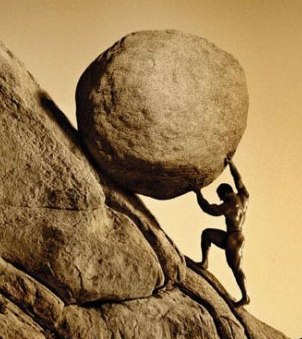 Suddenly I realized for myself the fresh breeze that rises up when the great burden is laid down. -Fayan Most of us go through life with a feeling of struggle. We may have the feeling that there is something wrong with us that we must fix. Or perhaps it's a constant sense that the world is not the way we want it to be, leading to chronic resentment and distress. And, of course, there's our partner, our parents, or kids, or boss, who definitely need to change in order for things to be alright. And, when we begin to meditate, we find struggle there too. Our mind wanders constantly, and we have the sense of not being able to do it right. We imagine that when we meditate we should be calm, present, and compassionate, but so often that's not at all what's happening. It's easy to give up. At the core of our struggle is not wanting to be with life as it is. We feel a constant need to figure out the problem and fix it, with ourselves, with our relationships, with society, and even in our meditation. In fact, we become addicted to struggle. We have formed our identity around it, around our narrative that "The problem is.... (fill in the blank)." We put tons of mental and emotional energy into trying to fix things so that they are the way we think they need to be, and then casting blame when this doesn't work. Constant discontent. Constant struggle. How can we, like Fayan, put down the great burden and experience the fresh breeze of intimacy with the world as it is? We can begin to explore this in our meditation. The key is acceptance of what is, without judgment. Your mind, just as it is, even in it's jumpiness or confusion or anxiety, doesn't need to change. We can welcome our experience with kindness and curiosity, just as it is. Put down the great burden of struggle, of judgment and comparison, of right and wrong, good and bad. Beyond our attempts to "fix" and control life, there is a way to walk in the fresh breeze of life as it is. I'll meet you there.
1 Comment
 As Tim began his first meditation retreat, he began to notice a contraction in his heart that pained and frightened him. His old fear that his heart could just stop was happening, and his panic was rising. His teacher had told him to simply notice sensations and feelings, so he tried to just sit with what was happening. Tim had respect for the teachings, so he followed the instructions, even as his experience of panic and pain grew larger. “What is wrong with me that I can’t do this simple thing?” he thought. He began to attack himself internally, blaming himself for his overwhelming emotions and his failure as a meditation student. He also became frightened that everyone in the meditation hall could see what was happening to him, and were judging him. Eventually the feelings became so overwhelming that he ran out of the retreat center. Tim’s experience is not uncommon. Many meditators have suffered trauma, often more than they are consciously aware of. While meditation can be an important way to work with physical, mental, and emotional states, including trauma, it needs to be approached with skill and care. Trauma in Meditation Traumatic experiences are more likely to emerge in meditation than in everyday life because we don’t have our ususal ways to distract ourselves. Anyone who experiences overwhelming feelings, physical pains, or repetitive attacking thoughts during meditation may be having a version of PTSD. This can happen to people who don’t think of themselves as having trauma in their lives. Other signs of trauma that can show up in meditation are insomnia, anxiety, depression, and physical pains or problems of a vague or unexplained nature. A Team Approach There are ways to work with traumatic states that arise in meditation, but skill and care is required. It’s best for the practitioner to work with a meditation teacher with awareness, training, and experience in working with arising trauma. Many traditional teachers and practices don’t take emotional states into account. However a growing number of contemporary teachers also have training in psychology and can help a student to navigate these difficult waters. It is also best for the practitioner to have a therapist skilled in working at the interface of meditation and trauma. She or he will likely need a safe place, in addition to the meditation center, to talk about difficult things that have come up in life, and to develop skills to notice and respond to traumatic states as they arise. Meditation alone is unlikely to resolve trauma. Meditating at the Edge of Trauma For people who are feeling overwhelmed by their thoughts or feelings, seated meditation isn’t the best practice. Try walking meditation, or doing a simple activity such as washing dishes. If what’s happening in your meditation is too much, change it up. Go into nature and touch the earth. To begin to use difficult states as a path of self-discovery and healing, have the support of a skilled teacher or therapist. The trauma researcher Peter Levine says that titrating painful states is key. It is important to be able to move back and forth between an experience of safety, such as a pleasant or neutral sensation in the body, and allowing for the edge of the traumatic sensation. As the trauma state gets more intense, move back to the felt sense of safety. This oscillation will, over time, allow for the distressing state to be held alongside and within a sense of safety and connection. Indeed trauma can be used as a fuel for radical self-discovery and healing. However the path is long and intense, and must be navigated with compassion, skill, and care by all involved. |
Details
AuthorMegan Rundel is the resident teacher at the Crimson Gate Meditation Community in Oakland, CA.. Archives
April 2020
Categories
|

 RSS Feed
RSS Feed